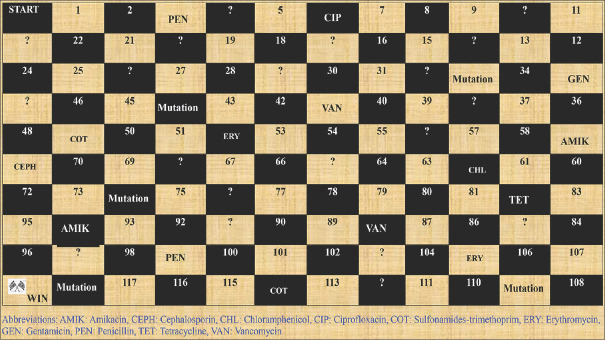Abstract
BACKGROUND:
Gamification involving application of elements of game play that provides unique opportunities to learners to sail through complex medical concepts is gaining importance in medical education. The current study was aimed at assessing the perception of medical students regarding checkerboard game in enhancing learning process.
MATERIALS AND METHODS:
The present prospective cross-sectional study was conducted at the microbiology department. The fifth-year medical students of the academic year 2018–19 were the participants. Pre- and post-test scores and self-administered questionnaire regarding effectiveness of the checkerboard game-based learning were used as assessing tools. The data were collected, tabulated, and statistically analyzed using SPSS version 20. The pre- and post-test scores of students were statistically analyzed using paired t test. A descriptive analysis on the 3-point Likert scale of effectiveness survey was measured and expressed in percentages.
RESULTS:
In total, 124 fifth-year medical students participated in the study. Majority (89.5%) of them liked the game, nearly 86% opined that game was enjoyable and created interest. Approximately 88% indicated game helped them to understand the topic, enhanced learning, and thus improved the knowledge. Most students (79%) also believed that game encouraged critical thinking and problem solving, while 75% felt that it improved their communication skills. Around 70% felt that game was also useful for exam preparation and nearly 90% recommended to use the game more frequently.
CONCLUSION:
From the results of the study, it can be concluded that checkerboard game-based learning method is effective in fostering learning process and cognition of medical students in the microbiology course.
Keywords: Antimicrobial agents, gamification, knowledge, learners, medical education
Introduction
One of the main hurdles in medical education is the mammoth quantity of knowledge students must acquire in a limited time.[1,2] It is a great challenge for medical educators to design and implement teaching methods that promise improvement in students’ learning and academic performance.[3,4] To tame this problem and achieve better results, in the past two decades, medical curricula have been modified.[3] The rapid progress in modern technology has resulted in a paradigm shift in medical education globally from teacher-centered to learner-centered learning approaches.[4,5,6,7] Several learner-centered active learning approaches such as problem-based learning (PBL), crossword puzzles, card and board games, role-playing, case-based learning, team-based learning, Kahoot online quizzes, and others have been implemented in curricula by medical educators globally.[8,9,10,11,12,13,14,15] Literature indicates that these alternative teaching approaches which are student focused are more effectual in promoting students’ interest and enhancing their knowledge as compared to teacher-centered traditional didactic lectures, where students are passive learners.[12,13,14,15,16,17]
Medical microbiology is one of the courses taught in the fifth-year integrated curricula at the College of Medicine and Health Sciences (COMHS), National University of Science and Technology, Oman. In this course, students are required to learn about pathogens and their pathogenic mechanisms, clinical features, laboratory diagnosis of infectious diseases, and their management including pharmacotherapy. Students must acquire strong comprehensive knowledge and apply this knowledge for better understanding of clinical diseases, diagnosis, and their management.[6] Students often struggle to learn and understand complexity of the topics covered in microbiology. Hence, it is imperative to train the students in microbiology course using active learning tools that encourage students’ learning and foster their critical thinking, interpretational skills, collaborative learning, communication skills, and cognition.[6]
Studies have shown that present millennial learners are likely to remain better engaged in an educational activity if game-based technology is involved.[18,19] Game-based learning methods are widely recognized as games are more effective, involve easy learning process, learner centered, interesting, and fun filled.[20] Kahoot on line quizzes, Web-based learning techniques, Card and board games including checkerboard are few platforms that involve gamification.[2,17,18,19] Gamification in education refers to the utilization of game mechanics with preset rules to promote learners’ engagement and stimulate their active participation, thus improving their knowledge rather than just entertainment.[2,20] Card and board games promise higher motivation among students and enhance their learning process in an interactive, rule-based, and competitive way.[18] Furthermore, game-based learning allows active discussion among learners that assist in enhancing learners’ communication skills, critical thinking, problem-solving ability, and social collaboration, and thereby result in the attainment of higher order cognition,[2,20] all of which are highly essential prerequisite for medical students.[2] On thorough literature search, the authors could not find research studies on effectiveness of checkerboard game-based learning among undergraduate medical students in microbiology courses. Hence, this study was carried out to implement checkerboard games in microbiology courses and assess students’ perception on the usefulness of this game-based learning in promoting their learning process.
Materials and Methods
Study design and setting
Game design
The current study was a cross-sectional study. The checkerboard game originally designed by Valente et al. was modified and used for the activity[2] Checkerboard game activity was conducted on the topic of mechanism of antibiotic action and antimicrobial resistance. The design of the card and board used for checkerboard game activity is illustrated in Figures 1–3.
Figure 1.
Illustration of board used for the checkerboard game activity
Figure 3.
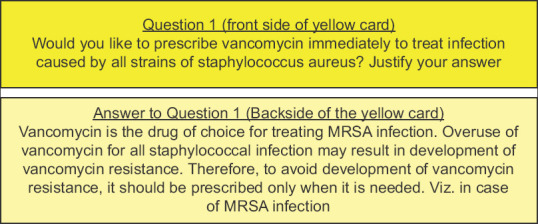
Example of a yellow card used for the activity
The game consists of illustrated board [Figure 1] and is played with dice and pawns. The game board consists of 120 squares with start and endpoints. The students were instructed to move their pawns along the path as directed in the board. This path contains 78 numbered squares, 15 squares with names of antibiotics, 5 squares with mutation, and 22 squares with a question mark. Two types of cards, red and yellow, were used. Each red card [Figure 2] consists of a clinical case scenario, the pathogen which is isolated, and its antibiotic susceptibility pattern. In red card, there is also an information regarding the susceptibility change in case of mutation of the microorganism. Another type of card is a yellow card [Figure 3], each yellow card has a question on its front side and the answer to the question on the backside of the card.
Figure 2.
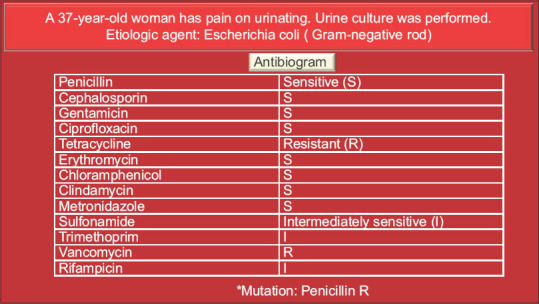
An example of a red card used for the activity
The study material of the topic for the activity was provided to all the participants 1 week prior to the activity. On the day of the activity, students were divided into a group of 10 and from each group, one player was selected as a captain by the group members to monitor the group. Detailed information about the rules of the game and how to play was instructed to everyone. Before starting the game, students were asked to complete the pretest individually. The pretest consisted of 10 questions related to learning objectives of the topic to know their previous knowledge. After collecting the pretest papers, a game board, red and yellow cards, dice, and pawns were provided to each group. Each student in the group was allowed to pick up one red card containing unique information such as clinical case scenario, pathogen isolated from the clinical specimen, and antibiotic susceptibility pattern. Students must carry the same red card till the end of the game. The students in the group were instructed to begin the game by keeping their respective color-coded pawns at the start point of the checkerboard. Each player rolls the dice and play in rotation in a clockwise direction. The player who starts the game must roll the dice and move his/her pawn according to the rolled number along the path on the board. Whenever a player stands on the square with a name of an antibiotic on it, he/she must check his/her red card for antibiotic susceptibility pattern (susceptible/resistance/intermediate) of the corresponding antibiotic. If the pathogen is susceptible, the player moves his/her dice three squares ahead; if resistant, a player moves his/her dice one square back; and if intermediate, a player will remain in the same square.
Whenever the player lands on a square with a question mark, the player immediately on his left must take out one of the yellow cards from the top of the stack of yellow cards and read the question written on the front side of the group. The player who has landed on the question mark square must answer the question first. If he/she could not answer, the question will be passed to other players (except the person holding the yellow card) in a clockwise direction until a question is answered. After an answer was obtained or no one in the group was unable to answer the question, the player holding the yellow card must read out the answer for the question written on the backside of the card. Everyone in the group must discuss and decide whether the answer given by group members is correct or not. If the answer is correct, the player who answered the question correctly must move five squares ahead and if the answer is wrong, he must move back his pawn two squares backward. The yellow card will then be kept at the bottom of the yellow card stacks. The group leader decides the answer given by the player as correct or incorrect and accordingly awards the points. If his/her answer is wrong, answers of the other group members in a clockwise direction will be discussed by the group members to award points and each time, points will be awarded to one student only. If any player lands on a square written mutation on it, he must return to starting point (Initial Square) and should proceed again as explained above, except that he must follow antibiotic susceptibility pattern corresponding to the mutation of the suffered pathogen. The player will be considered winner when he reaches the final square (endpoint).
Study participants and sampling
The present study was conducted at the Department of Microbiology, COMHS, Oman. The fifth-year medical students of the academic year 2018–19 were the study participants. The study was approved by Institutional Ethic and Review Committee [Approval no: CMHS/REC/039/19/C]. All students were briefed about the study and all willing students were enrolled. Unwilling students and the students who did not complete the study were excluded from the study.
Data collection tool and technique
Pretest and posttest scores and self-administered questionnaire to assess medical students’ perception of the checkerboard game-based learning were used as assessing tools. The completed pretest and posttest forms were collected, tabulated, and evaluated. In addition, the completed predesigned self-administered questionnaire used to assess the students’ perception on the effectiveness of the checkerboard activity was collected at the end of the activity. The evaluation was performed on a 3-point Likert scale (3 = no, 2 = neutral, and 1 = yes). Annexure 1 is the sample of the questionnaire utilized for collecting the students’ responses on effectiveness of the checkerboard game based technique in promoting their learning process.
Statistical analysis
The data were collected, tabulated, and statistically analyzed using Microsoft Excel and Statistical Package for the Social Sciences (SPSS) software, version 20 (SPSS Inc., Armonk, NY: IBM Corp). The test items were scored as 1 for correct and 0 for wrong. The scores were calculated by adding up the item scores for pre- and posttests. The pretest and posttest scores of students were statistically analyzed using paired t-test. A descriptive analysis on the Likert scale of effectiveness survey was performed and tabulated.
Ethical consideration
The current study was approved by the Institutional Research and Ethics Committee [Approval no: CMHS/REC/039/19/C].
Results
In total, 124 medical students of the academic year 2018–19 were participated in the study. The paired sample t-test between pre- and post-test scores [Figure 4] of the checkerboard activity showed considerable improvement in the knowledge of students (t = −64.122; df = 123; P < 0.0001). Table 1 depicts the results of questionnaire regarding participants’ opinions on the effectiveness of the checkerboard activity in their learning process in microbiology. All students said that game design was clear, majority (89.5%) of them liked the game, nearly 86% opined game was enjoyable and created interest, and 87% believed the game promoted their active participation. Approximately 88% indicated that game helped them to understand the topic, it is an important way of enhancing learning, and thus improves the knowledge. Most students (79%) also believed that game encouraged critical thinking and problem solving, while 75% felt that it improved their communication skills. Concerning exam preparation, 71% opined that game would help in identifying and understanding key concepts of the topic and thus benefits in better exam preparation. Finally, most (88%) of the students considered checkerboard as a good/excellent tool and suggested for conducting such activity more frequently. Figure 5 depicts the world cloud of global comments by our participants related to perception of checkerboard activity.
Figure 4.
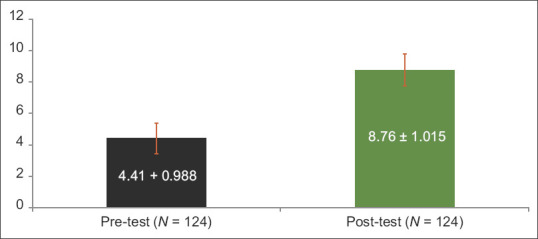
Pretest and Posttest scores
Table 1.
The opinion of students regarding the usefulness of checkerboard activity
| Questionnaire | No n (%) | Neutral n (%) | Yes n (%) |
|---|---|---|---|
| Did you like the checkerboard activity? | 1 (0.8) | 12 (9.7) | 111 (89.5) |
| Was the design of the game clear? | 0 | 0 | 124 (100) |
| Do you think checkerboard activity is enjoyable and creates interest in the topic? | 6 (4.8) | 11 (8.9) | 107 (86.3) |
| Do you think checkerboard activity stimulated your active participation in discussion? | 11 (8.9) | 5 (4) | 108 (87.1) |
| Did the game help you to understand the topic better? | 6 (4.8) | 8 (6.5) | 109 (87.9) |
| Do you think checkerboard game helped to improve your communication skills? | 14 (11.3) | 17 (13.7) | 93 (75) |
| Did the game help to improve your critical thinking or problem solving ability? | 12 ( 9.7) | 14 (11.3) | 98 (79) |
| Did the game improve your knowledge of the topic? | 7 (5.6) | 8 (6.5) | 109 (87.9) |
| Do you think checkerboard game based activity is a good educational tool to promote and improve students’ learning? | 8 (6.5) | 7 (5.6) | 109 (87.9) |
| Do you recommend to conduct such activity in future? | 2 (1.6) | 13 (10.5) | 109 (87.9) |
| Do you think checkerboard- game based activity help in better exam preparation? | 23 (18.5) | 13 (10.5) | 88 (71) |
Figure 5.
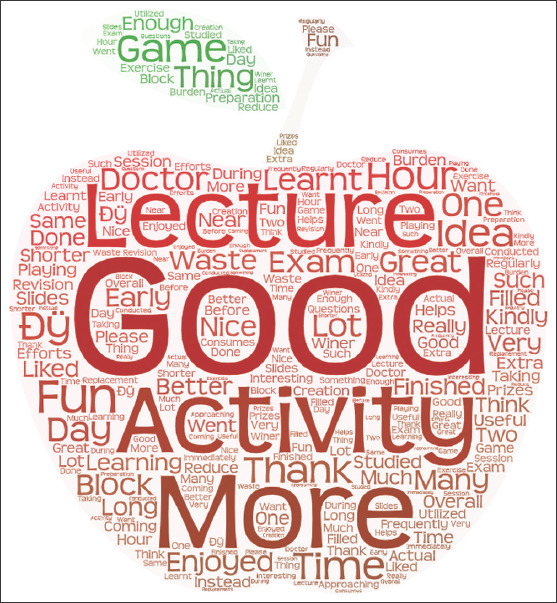
Word cloud of global comments on the perception of checkerboard activity
Discussion
Over the past couple of decades, with the advances in technology, there is growing evidence of adaption of gamification in medical education. The current millennial learners have better knowledge on digital game-based technology. Therefore, adapting to game-based teaching techniques in medical education would generate more inclination toward learning among medical students.[17,21] Literature search revealed use of several different game-based learning tools such as web-based, Kahoot, card, and board games by medical educators globally.[2,17] However, to the best of our knowledge, the present study pertaining to assessment of effectiveness of checkerboard game-based activity in promoting students’ learning is the first of its kind of study in microbiology.
Alternative teaching methods in microbiology are gaining importance because of several reasons. First, mammoth quantity of course material students must study, understand, and digest within a short period. Second, traditional didactic lectures involving delivery of content in a large classroom are less effective in provoking students’ interest, and fostering their interaction, active participation in discussion, and communication. To tame the shortfall of traditional didactic lectures, alternative teaching techniques including educational games are most valuable. In these game-based activities, students are divided into small groups and allowed to discuss on a particular topic. This, in turn, escalates learners’ motivation, engages, and energizes their active participation in discussion, and communication with peers. Several studies in the past have proved that learning techniques that involve learners’ active participation would result in acquisition of better knowledge.[22,23,24] In game-based learning, students learn by fun; hence, they are better motivated. Furthermore, games improve their active participation, enhance interaction and engagement, and improve communication with peers.[20] In our study, majority (86%) of participants welcomed the game and felt that the game was enjoyable and provoked their interest on the topic, also expressed that the game stimulated their active participation in discussion and communication with the peers of the group, thus their knowledge on the topic was improved significantly. This students’ perception was supported by considerable improvement in posttest scores compared to pretest scores of the participants (P < 0.0001), suggesting significant refinement in their intellectual skills. A similar study conducted by Valente et al. also showed improvement in posttest scores of the participants.[2] For a question asked in relation to usefulness of the game in academic exam preparation, approximately 30% responded either as no or neutral. Some of the participants opined that the usefulness of checkerboard game in exam preparation with couple of activity cannot be judged. However, 70% believed that game would help in identifying key areas and understanding key concepts of the topic, thus would lead to better exam preparation. One of the limitations of our study is we did not analyze game-based learning and its outcome on exam results. Therefore, further studies are needed to confirm this students’ perception by comparing students’ exam scores on the topics covered through the game with the topic covered by regular didactic lectures or other teaching modalities. Overall, most students expressed their satisfaction for the game and suggested for conducting game-based activities frequently. Finally, most educational games are inexpensive, feasible, widely accepted by learners, and are effective in enhancing learning process, thus making them better learners.[25]
Limitations and recommendation
The present study has few limitations. It is a single-centered study with a small sample size (n = 124) comprising fifth-year medical students of COMHS. Hence, findings of our study cannot be generalized, and the results must be validated by further multicentric studies.
Conclusion
From the current study, it is recommended that checkerboard game-based activity is an effective education tool to promote a powerful learning experience among medical students in undergraduate medical courses including microbiology. Furthermore, because of feasibility and easy adaptability, the checkerboard can be considered as a perfectly tailored invaluable, inexpensive, and highly effective tool to improve students’ engagement, communication, and cognition.
Financial support and sponsorship
Nil.
Conflicts of interest
There are no conflicts of interest.
Acknowledgment
The authors were indebted to fifth-year medical students of COMHS of the academic year 2018–19 for their active participation.
References
- 1.Majed HA, Park YS, Tekian A. Assessment of educational games for health professions: A systematic review of trends and outcomes. Med Teach. 2015;37:S27–32. doi: 10.3109/0142159X.2015.1006609. [DOI] [PubMed] [Google Scholar]
- 2.Valente P, Lora PS, Landell MF, Schiefelbein CS, Girardi FM, Souza LD, et al. A game for teaching antimicrobial mechanisms of action. Med Teac. 2009;31:e383–92. doi: 10.1080/01421590802637958. [DOI] [PubMed] [Google Scholar]
- 3.Kim KJ, Hwang JY. Characteristics of medical teachers using student-centered teaching methods. Korean J Med Educ. 2017;29:187–91. doi: 10.3946/kjme.2017.64. [DOI] [PMC free article] [PubMed] [Google Scholar]
- 4.Jacobs JC, van Luijk SJ, van der Vleuten CP, Kusurkar RA, Croiset G, Scheele F. Teachers’ conceptions of learning and teaching in student-centred medical curricula: The impact of context and personal characteristics. BMC Med Educ. 2016;16:244. doi: 10.1186/s12909-016-0767-1. [DOI] [PMC free article] [PubMed] [Google Scholar]
- 5.Mohan BS, Nambiar V, Aravindakshan R. Patient-oriented problem-solving: An effective educational tool for learning immunology. Int J Dent Med Spec. 2016;4:2–7. [Google Scholar]
- 6.Kyong-Jee K, Jee-Young H. Characteristics of medical teachers using student-centered teaching methods. Korean J Med Educ. 2017;29:187–91. doi: 10.3946/kjme.2017.64. [DOI] [PMC free article] [PubMed] [Google Scholar]
- 7.Sannathimmappa MB, Nambiar V, Aravindakshan R. implementation and evaluation of case-based learning approach in microbiology and immunology. Int J Med Res Health Sci. 2019;8:1–5. [Google Scholar]
- 8.Chang BJ. Problem-based learning in medical school: A student's perspective. Ann Med Surg (Lond) 2016;12:88–9. doi: 10.1016/j.amsu.2016.11.011. [DOI] [PMC free article] [PubMed] [Google Scholar]
- 9.Mohan BS, Nambiar V, Gowda S, Aravindakshan R. Crossword puzzle: A tool for enhancing medical students’ learning in microbiology and immunology. Int J Res Med Sci. 2018;6:756–9. [Google Scholar]
- 10.Burgess A, Bleasel J, Haq I, Roberts C, Garsia R, Robertson T, Mellis C. Team-based learning (TBL) in the medical curriculum: Better than PBL? BMC Med Educ. 2017;17:243. doi: 10.1186/s12909-017-1068-z. [DOI] [PMC free article] [PubMed] [Google Scholar]
- 11.Mohan BS, Nambiar V, Aravindakshan R. Implementation, and assessment of students’ perception on effectiveness of Kahoot game-based educational tool in learning microbiology. J Biomed Pharm Res. 2018;7:12–8. [Google Scholar]
- 12.McLean SF. Case-based learning and its application in medical and health-care fields: A review of worldwide literature. J Med Educ Curric Dev. 2016;3:39–49. doi: 10.4137/JMECD.S20377. [DOI] [PMC free article] [PubMed] [Google Scholar]
- 13.Hew KF, Lo CK. Flipped classroom improves student learning in health professions education: A meta-analysis. BMC Med Educ. 2018;18:38. doi: 10.1186/s12909-018-1144-z. [DOI] [PMC free article] [PubMed] [Google Scholar]
- 14.Dadgar MM, Khadem-Rezaiyan M. Oral presentation versus role playing in medical education: A quasi-experimental study. Strides Dev Med Educ. 2018;15:e84863. [Google Scholar]
- 15.Nouri J. The flipped classroom: For active, effective, and increased learning especially for low achievers. Int J Educ Technol Higher Educ. 2016;13:33. [Google Scholar]
- 16.Gorbanev I, Agudelo-Londoño S, González RA, Cortes A, Pomares A, Delgadillo V, et al. A systematic review of serious games in medical education: Quality of evidence and pedagogical strategy. Med Educ Online. 2018;23:1438718. doi: 10.1080/10872981.2018.1438718. [DOI] [PMC free article] [PubMed] [Google Scholar]
- 17.Felszeghy S, Pasonen-Seppänen S, Koskela A, Nieminen P, Harkonen K, Paldanius KM, et al. Using online game-based platforms to improve student performance and engagement in histology teaching. BMC Med Educ. 2019;19:273. doi: 10.1186/s12909-019-1701-0. [DOI] [PMC free article] [PubMed] [Google Scholar]
- 18.Boeker M, Andel P, Vach W, Frankenschmidt A. Game-based e-learning is more effective than a conventional instructional method: A randomized controlled trial with third-year medical students. PLoS One. 2013;8:e82328. doi: 10.1371/journal.pone.0082328. [DOI] [PMC free article] [PubMed] [Google Scholar]
- 19.Kerfoot BP, Baker H, Pangaro L, Agarwal K, Taffet G, Mechaber AJ, et al. An online spaced-education game to teach and assess medical students. Acad Med. 2012;87:1443–9. doi: 10.1097/ACM.0b013e318267743a. [DOI] [PubMed] [Google Scholar]
- 20.Pesare E, Roselli T, Corriero N, Rossano V. Game-based learning and Gamification to promote engagement and motivation in medical learning contexts. Smart Learn Environ. 2016;3:5. [Google Scholar]
- 21.Kapralos B, Fisher S, Clarkson J, Van-Oostveen R. A course on serious game design and development using an online problem-based learning approach. Interactive Technol Smart Educ. 2015;12:116–36. [Google Scholar]
- 22.Smiderle R, Rigo SJ, Marques LB, Coelho JA, Jaques PA. The impact of gamification on students’ learning, engagement and behavior based on their personality traits. Smart Learn Environ. 2020;7:1–11. [Google Scholar]
- 23.Dichev C, Dicheva D. Gamifying education: What is known, what is believed and what remains uncertain: A critical review. Int J Educ Technol Higher Educ. 2017;14:9. [Google Scholar]
- 24.Sannathimmappa MB, Nambiar V, Aravindakshan R, Kumar A. Are Online Synchronous Team-BasedLearning (TBL) pedagogy effective?: Perspectives from a study on medical students in Oman. J Adv Med Educ Prof. 2022;10(1):12–21. doi: 10.30476/JAMP.2021.92361.1481. DOI: 10.30476/JAMP.2021.92361.1481. [DOI] [PMC free article] [PubMed] [Google Scholar]
- 25.Akl EA, Mustafa R, Slomka T, Alawneh A, Vedavalli A, Schünemann HJ. An educational game for teaching clinical practice guidelines to Internal Medicine residents: Development, feasibility, and acceptability. BMC Med Educ. 2008;8:50. doi: 10.1186/1472-6920-8-50. [DOI] [PMC free article] [PubMed] [Google Scholar]



